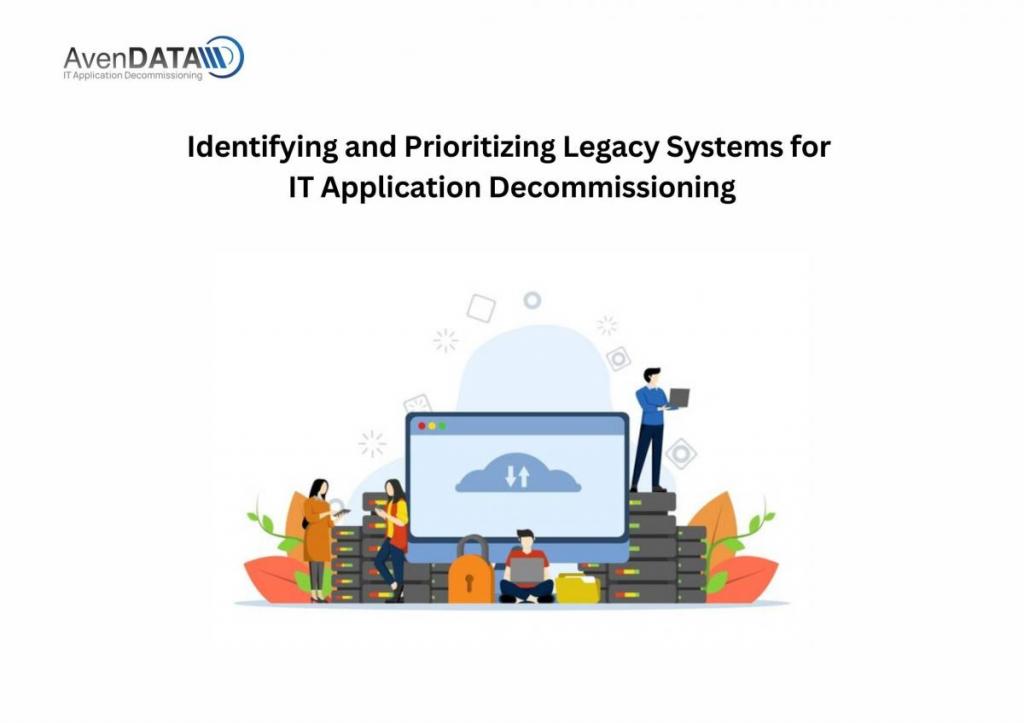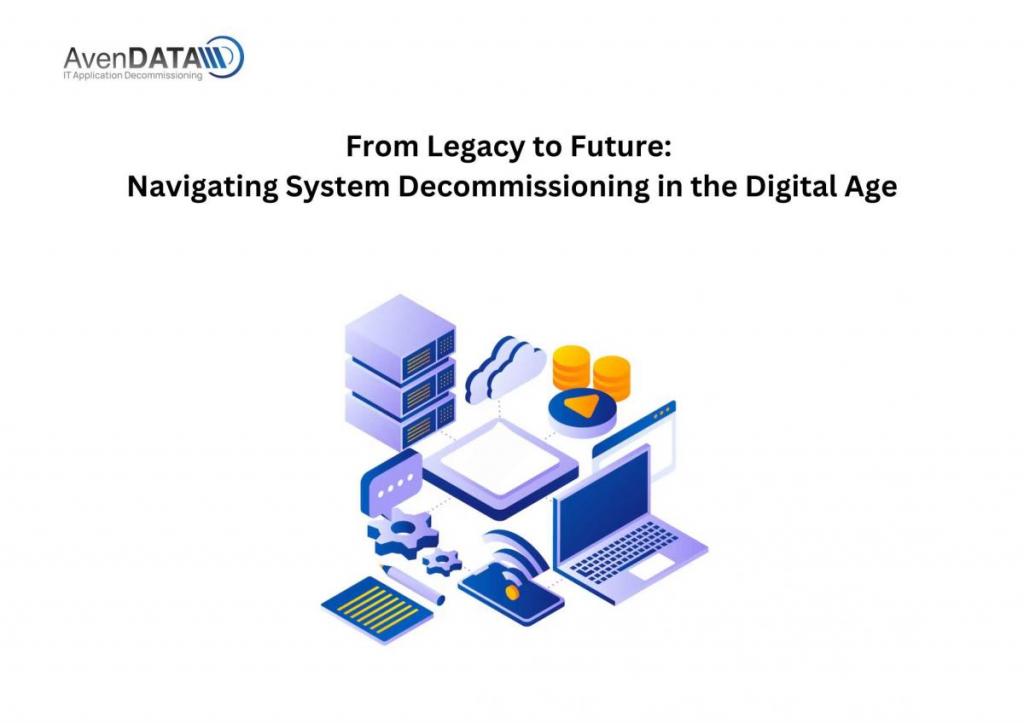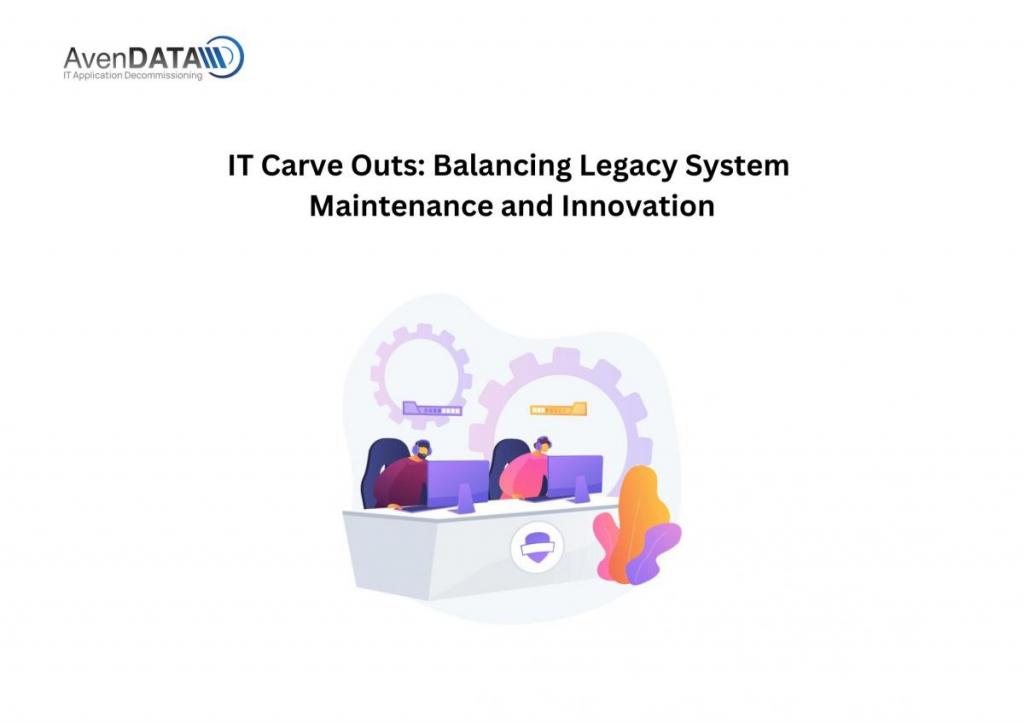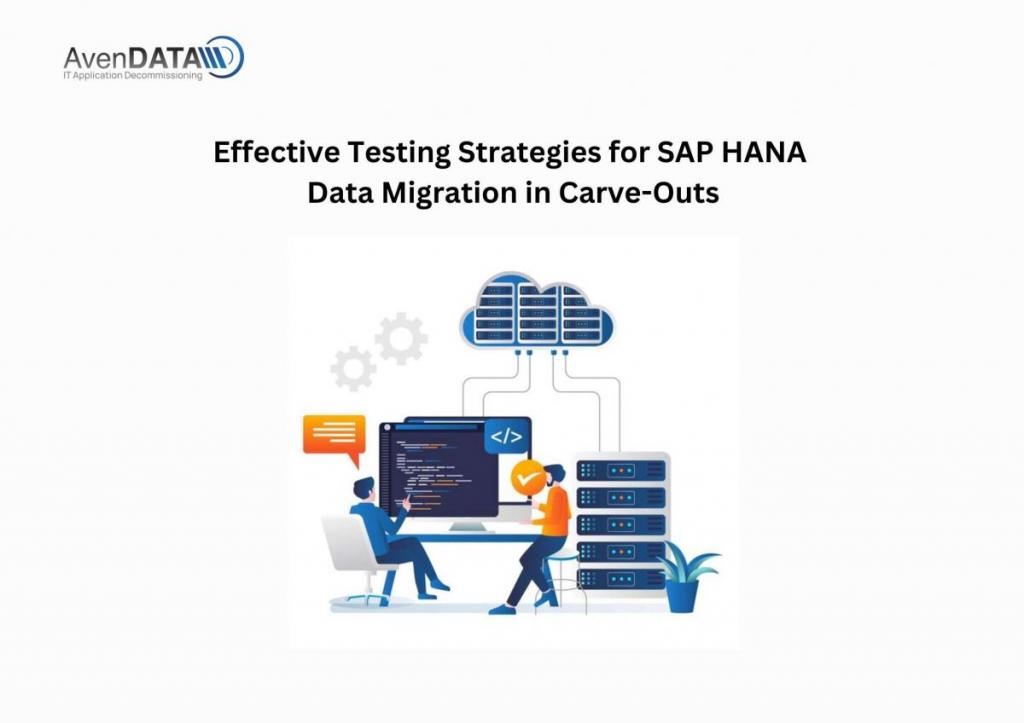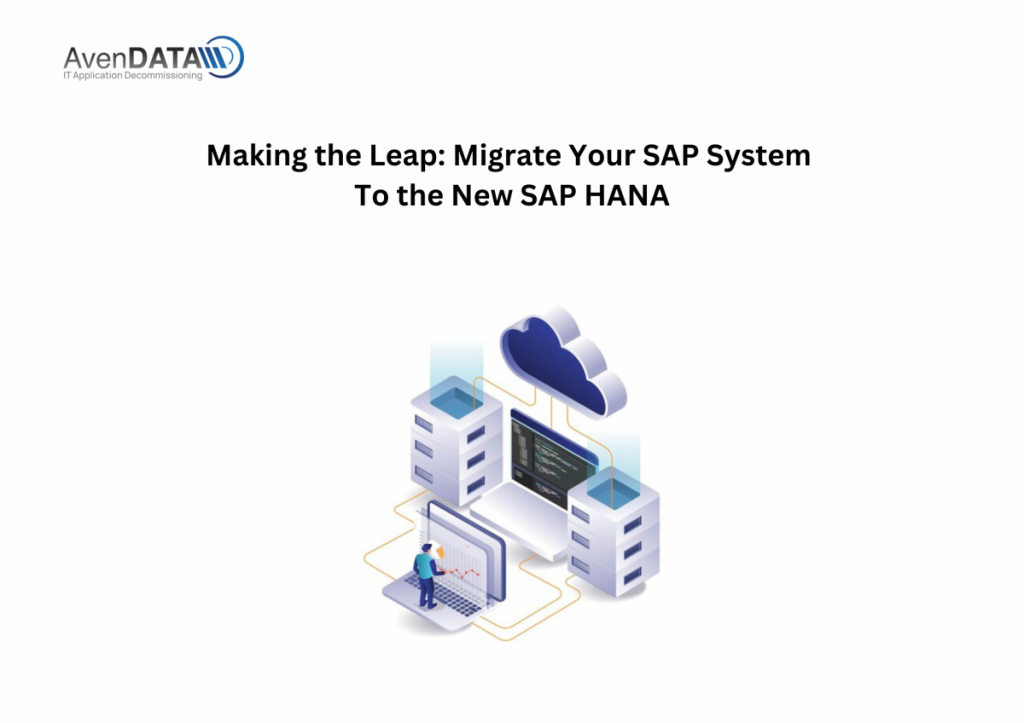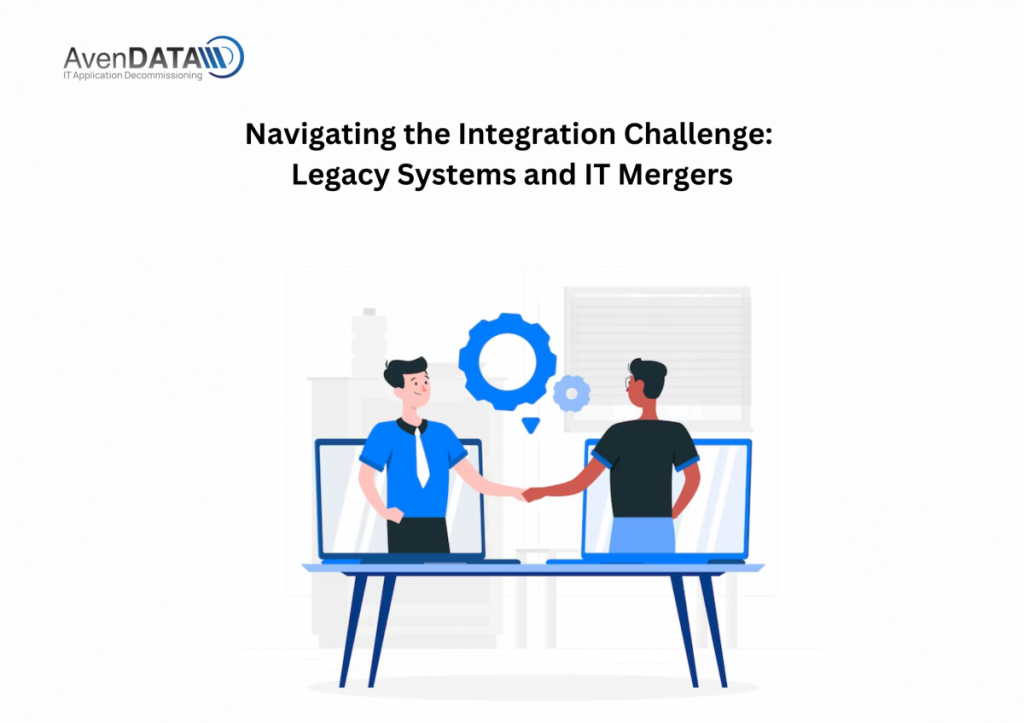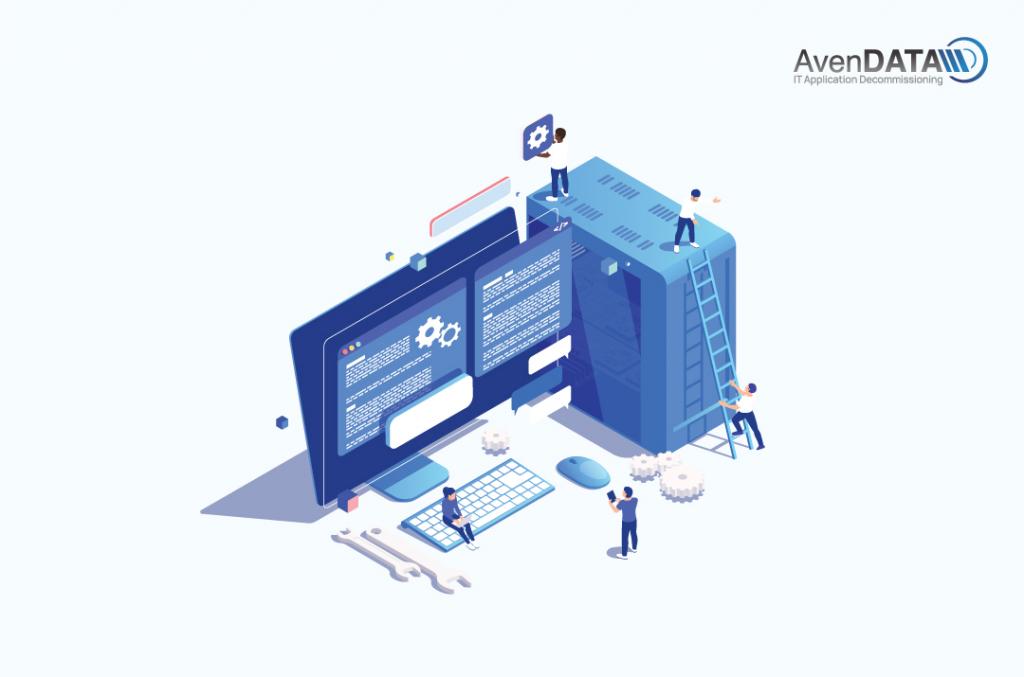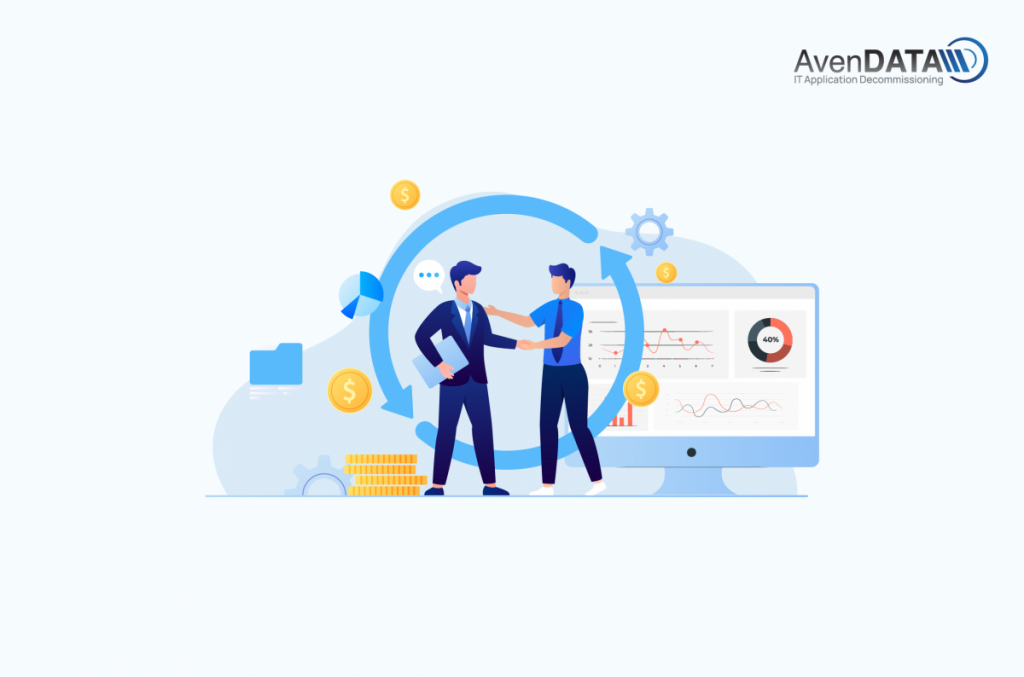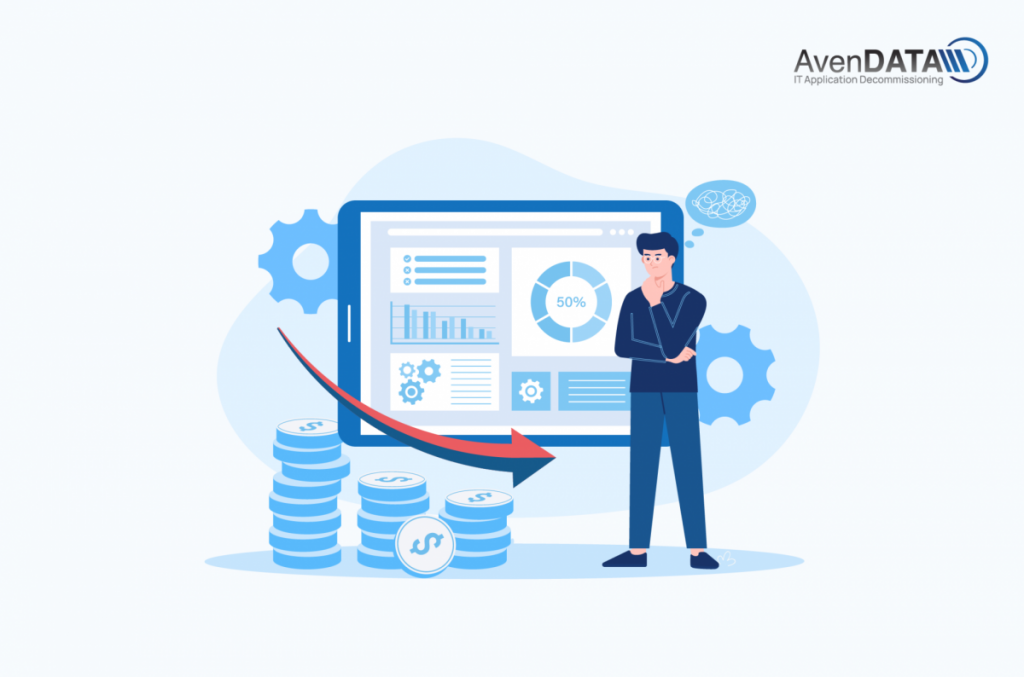Identifying and Prioritizing Legacy Systems for IT Application Decommissioning
Introduction: As technology evolves at a rapid pace, organizations often find themselves burdened with outdated and inef... View MoreIdentifying and Prioritizing Legacy Systems for IT Application Decommissioning
Introduction: As technology evolves at a rapid pace, organizations often find themselves burdened with outdated and inefficient legacy systems. These legacy systems not only hinder operational efficiency but also pose security and maintenance risks. IT application decommissioning is a strategic process that involves retiring and replacing these legacy systems to streamline operations and drive innovation. In this blog, we will explore the importance of identifying and prioritizing legacy systems for IT application decommissioning, providing organizations with a roadmap to modernization.
Assessing the Business Impact: Start by assessing the business impact of each IT legacy system. Evaluate how critical the system is to daily operations, customer experience, and revenue generation. This assessment will help prioritize systems based on their potential impact on the organization.
Analyzing Technical Health: Evaluate the technical health of each legacy system. Consider factors such as system performance, stability, security vulnerabilities, and compatibility with modern technologies. Systems that are outdated and difficult to maintain or integrate should be given higher priority for decommissioning.
Conducting Cost-Benefit Analysis: Perform a cost-benefit analysis to determine the financial implications of decommissioning each legacy system. Consider factors such as maintenance costs, licensing fees, potential savings from retiring the system, and the cost of replacing it with a modern solution. Prioritize systems that offer the highest return on investment (ROI) through decommissioning.
Assessing User Adoption and Satisfaction: Evaluate user adoption and satisfaction with each legacy system. Identify systems that are underutilized or disliked by users, as they may be good candidates for decommissioning. Engage with system users to gather feedback and understand pain points, which will help inform the decision-making process.
Considering Integration and Interdependencies: Assess how legacy systems integrate with other applications and systems within the organization’s technology landscape. Identify systems with complex integration requirements or those that create bottlenecks in data flow. Prioritize decommissioning systems that hinder agility, scalability, or interoperability.
Conducting Regulatory Compliance Analysis: Evaluate the regulatory compliance requirements associated with each legacy system. Identify systems that pose compliance risks or require significant effort to maintain compliance. Prioritize decommissioning systems that are non-compliant or have a higher risk of non-compliance.
Aligning with Strategic Goals: Align the decision-making process with the organization’s strategic goals and long-term vision. Identify legacy systems that no longer support business objectives or hinder innovation. Prioritize decommissioning systems that prevent the organization from embracing new technologies or pursuing growth opportunities.
Developing a Decommissioning Roadmap: Based on the assessment of each legacy system, develop a decommissioning roadmap that outlines the sequence and timeline for retirement. Consider dependencies, resource availability, and potential risks during the transition. Engage stakeholders to gain their buy-in and support for the decommissioning process.
Planning for Data Migration and Archiving: Create a plan for migrating and archiving data from the decommissioned systems. Ensure that data integrity and security are maintained during the transition. Collaborate with data management teams to establish proper procedures for data extraction, transformation, and storage.
Executing the Decommissioning Process: Execute the decommissioning process in a phased and controlled manner. Communicate the changes to stakeholders and provide necessary training and support for users transitioning to new systems. Monitor the process closely to address any unforeseen challenges and ensure a smooth transition.
Conclusion: Identifying and prioritizing legacy systems for IT application decommissioning is a crucial step in modernizing an organization’s technology landscape. By assessing the business impact, technical health, cost-benefit analysis, user adoption, regulatory compliance, and alignment with strategic goals, organizations can create a roadmap for retiring legacy systems. Through careful planning and execution, organizations can streamline operations, reduce costs, enhance security, and position themselves for future growth and innovation. Embrace the opportunity to embrace new technologies and leave behind the burden of outdated legacy systems.
Know more : https://avendata.com/application-decommissioning
#AvenDATA #itapplicationdecommissioning #itdecommissioning #applicationdecommissioning #Itlegacysystem #legacysystem
From Legacy to Future: Navigating System Decommissioning in the Digital Age
In the ever-evolving world of technology, organizations are constantly striving to modernize their IT infrastructure to kee... View MoreFrom Legacy to Future: Navigating System Decommissioning in the Digital Age
In the ever-evolving world of technology, organizations are constantly striving to modernize their IT infrastructure to keep pace with advancements and remain competitive. However, this often leaves behind a trail of legacy systems, outdated applications that are no longer supported, maintained, or aligned with current business needs. These systems can pose significant risks to an organization’s security, performance, and compliance efforts.
System decommissioning, the process of systematically retiring and removing outdated applications and systems from an organization’s IT environment, is a critical step in streamlining IT operations, reducing costs, and enhancing overall agility. However, navigating system decommissioning in today’s digital age presents unique challenges that require careful planning and strategic execution.
The Challenges of Legacy System Decommissioning
Legacy system decommissioning can be a complex and challenging process due to several factors:
Interdependencies: Legacy systems are often tightly integrated with other systems, making it difficult to remove them without disrupting core business processes.
Data migration: Migrating data from legacy systems to new platforms can be time-consuming and error-prone, requiring careful planning and data integrity checks.
Security risks: Legacy systems may contain sensitive data and may not have the latest security features, increasing the risk of data breaches during decommissioning.
Compliance considerations: Organizations must ensure that system decommissioning complies with data privacy regulations and industry standards.
Change management: Decommissioning can disrupt business operations and user workflows, requiring effective communication and change management strategies.
A Strategic Approach to System Decommissioning
To effectively navigate system decommissioning in the digital age, organizations should adopt a strategic approach that encompasses the following key steps:
Identify and prioritize systems for decommissioning: Assess the legacy systems within the organization’s IT landscape and prioritize them for decommissioning based on their impact on business operations, security risks, and maintenance costs.
Plan and document the decommissioning process: Develop a comprehensive decommissioning plan that outlines the steps involved, including data migration, application removal, and system disposal. Clearly document the plan to ensure consistent execution and minimize disruptions.
Engage stakeholders and communicate effectively: Communicate the decommissioning plan to all relevant stakeholders, including employees, customers, and suppliers. Provide clear timelines, potential disruptions, and any changes to business processes.
Utilize technology tools and expertise: Leverage technology tools to automate tasks such as data migration, system configuration, and documentation. Engage experts with experience in system decommissioning to ensure the process is executed smoothly and efficiently.
Test and monitor the decommissioning process: Conduct thorough testing to ensure that systems are properly decommissioned and that data is migrated accurately. Continuously monitor the process to identify and address any issues promptly.
Dispose of systems securely: Dispose of decommissioned hardware and software in a secure and environmentally friendly manner. Comply with data disposal regulations and ensure that sensitive data is destroyed or securely archived.
Evaluate lessons learned and refine processes: After decommissioning, evaluate the process to identify areas for improvement. Document lessons learned and refine processes for future decommissioning projects.
Conclusion
System decommissioning is an essential part of IT modernization and can bring significant benefits to organizations, including reduced costs, improved security, enhanced agility, and streamlined operations. By adopting a strategic approach, utilizing technology tools, and effectively communicating with stakeholders, organizations can successfully navigate system decommissioning in the digital age and reap the rewards of a modernized IT infrastructure.
Know more : https://avendata.com/decommissioning-legacy-systems
#avendata #legacysystem #itlegacysystem #systemdecomissioning #itdecomissioning
IT Carve Outs: Balancing Legacy System Maintenance and Innovation
In today’s rapidly evolving technological landscape, organizations face a constant challenge: balancing the maintenance of legacy s... View MoreIT Carve Outs: Balancing Legacy System Maintenance and Innovation
In today’s rapidly evolving technological landscape, organizations face a constant challenge: balancing the maintenance of legacy systems with the pursuit of innovation. This challenge is particularly acute in the context of IT carve-outs, where organizations must carefully consider the implications of separating a portion of their IT infrastructure from the rest of the enterprise.
The Legacy System Conundrum
Legacy systems, though often outdated and complex, remain critical to many organizations’ operations. They hold valuable data, maintain essential business processes, and ensure continuity with established workflows. However, maintaining IT legacy systems can be costly and time-consuming, diverting resources away from innovation and modernization efforts.
The Innovation Imperative
In an increasingly competitive business environment, organizations must continuously innovate to stay ahead of the curve. This requires investing in new technologies, developing cutting-edge solutions, and adapting to evolving customer needs. However, the burden of legacy system maintenance can hinder innovation efforts, limiting the allocation of resources for research and development.
Striking a Balance: The Art of IT Carve-Outs
IT carve-outs offer a potential solution to this balancing act by separating legacy systems from the rest of the IT infrastructure. This allows organizations to focus on maintaining and modernizing legacy systems in a dedicated environment while simultaneously pursuing innovation in the core IT infrastructure.
Key Considerations for Effective IT Carve-Outs
To achieve a successful IT carve-out and strike the right balance between legacy system maintenance and innovation, organizations should consider the following factors:
Strategic planning: Clearly define the objectives of the carve-out and align IT activities with overall business goals.
Comprehensive assessment: Conduct a thorough assessment of IT infrastructure, applications, and data to identify potential challenges and opportunities.
Effective communication: Communicate IT carve-out plans and timelines to stakeholders, including employees, customers, and suppliers.
Technology tools and expertise: Utilize technology tools and engage experts to streamline data migration, application integration, and change management.
Continuous evaluation: Regularly evaluate the effectiveness of the carve-out and make adjustments as needed to ensure alignment with business objectives.
Conclusion
IT carve-outs can be a powerful tool for balancing legacy system maintenance and innovation, enabling organizations to safeguard their critical IT assets while simultaneously pursuing new opportunities for growth and transformation. By carefully planning, executing, and evaluating IT carve-out initiatives, organizations can optimize their IT resources, enhance operational efficiency, and position themselves for long-term success in the dynamic world of technology.
Know more : https://avendata.com/archiving-legacy-systems
#AvenDATA #legacysystems #ITlegacysystem #carveout #ITcarveout #dataarchiving #datacarveout
Effective Testing Strategies for SAP HANA Data Migration in Carve-Outs
In the ever-evolving landscape of business, carve-outs have become a common strategy for companies looking to separate a portion... View MoreEffective Testing Strategies for SAP HANA Data Migration in Carve-Outs
In the ever-evolving landscape of business, carve-outs have become a common strategy for companies looking to separate a portion of their operations. These complex endeavors often involve the migration of data from legacy systems to modern platforms like SAP HANA. The success of a carve-out project hinges significantly on the effectiveness of data migration, and one critical aspect of this process is testing.
The Importance of Testing
Testing is an integral component of SAP HANA data migration in carve-outs. It’s not just a routine step but a critical process that ensures the accuracy, functionality, and reliability of the migrated data. Effective testing strategies are the backbone of a successful carve-out, and they can significantly reduce the margin for error.
Key Considerations for Testing
To ensure a smooth SAP HANA data migration in carve-outs, consider the following key testing strategies:
1. Data Validation Testing
Data validation is at the core of the testing process. It involves checking if the data has been accurately transferred from the legacy systems to SAP HANA. This step ensures that the data retains its integrity during the migration.
2. Data Reconciliation Testing
Data reconciliation involves comparing the data in SAP HANA with the source data to identify discrepancies. This step helps detect any missing, incomplete, or duplicated data.
3. Performance Testing
Performance testing assesses the speed and efficiency of data retrieval and processing in SAP HANA. It helps identify bottlenecks or areas where system optimization may be needed.
4. Security Testing
Data security is a paramount concern in data migration. Security testing ensures that sensitive information remains protected throughout the process. It checks for vulnerabilities and access controls.
5. User Acceptance Testing (UAT)
UAT involves end-users testing the system to ensure it meets their requirements. This real-world testing helps uncover any usability issues and ensures that the system aligns with business needs.
6. Regression Testing
Regression testing assesses the impact of data migration on existing processes and systems. It helps identify any unintended consequences and ensures that the migration does not disrupt ongoing operations.
7. Compliance Testing
Maintaining regulatory compliance is crucial, especially in industries with stringent data privacy regulations. Compliance testing ensures that data handling aligns with legal requirements.
8. Load Testing
Load testing assesses the system’s performance under various loads, helping identify its capacity and potential limitations. This is particularly important for carve-outs involving a large volume of data.
The Role of Automation
Automation plays a pivotal role in testing strategies. Automated testing tools can streamline the process, increase efficiency, and reduce the risk of human error. These tools can be tailored to specific testing requirements, making them a valuable asset in SAP HANA data migration.
Conclusion
In the intricate world of carve-outs, SAP HANA data migration is a complex task that demands precision and meticulous planning. Effective testing strategies are the linchpin that holds the process together, ensuring that data is accurately transferred, secure, and compliant.
By prioritizing comprehensive testing, businesses can minimize the risks associated with data migration and carve-outs, ultimately leading to a successful transition. The testing phase is not just a formality but a critical step in securing the integrity of data and ensuring the carve-out’s success.
In a world where business transformations are a constant, effective SAP HANA data migration testing is the assurance that change can be managed with confidence and precision. It’s the key to a seamless carve-out and the foundation upon which businesses can build their future success.
Know more : https://avendata.com/sap-hana
#AvenDATA #SAPsystem #ITsystems #Legacysystem #ITlegacysystem #SAPhana
In the ever-evolving landscape of enterprise technology, staying ahead of the curve is imperative for businesses seeking to maintain their competitive edge. SAP HANA, with its in-memory computing capa... View MoreIn the ever-evolving landscape of enterprise technology, staying ahead of the curve is imperative for businesses seeking to maintain their competitive edge. SAP HANA, with its in-memory computing capabilities, has revolutionized the world of enterprise resource planning (ERP) systems. Migrating your existing SAP system to SAP HANA is a strategic move that promises improved performance, real-time analytics, and enhanced agility. In this blog, we’ll explore the significance of migrating to SAP HANA and the steps involved in this transformational journey.
The Significance of Migrating to SAP HANA
SAP HANA, short for High-Performance Analytic Appliance, is SAP’s revolutionary in-memory database management system. Its architecture allows for lightning-fast data processing and real-time analytics, enabling businesses to make quicker, data-driven decisions. Here’s why migrating to SAP HANA is a game-changer:
1. Lightning-Fast Performance:
— SAP HANA’s in-memory technology accelerates data processing, resulting in significantly faster application performance. Complex queries that used to take minutes now execute in seconds.
2. Real-Time Analytics:
— With SAP HANA, businesses can access real-time insights from their data, enabling faster responses to market changes and customer demands.
3. Simplified IT Landscape:
— Migrating to SAP HANA can lead to IT landscape simplification by eliminating the need for separate data warehousing solutions and reducing data duplication.
4. Enhanced User Experience:
— SAP HANA’s speed and efficiency translate into a smoother, more responsive user experience, boosting productivity across the organization.
5. Advanced Analytics and AI:
— SAP HANA opens the door to advanced analytics, machine learning, and artificial intelligence capabilities, allowing businesses to uncover deeper insights and automate processes.
Steps for Migrating to SAP HANA
Migrating to SAP HANA is a multi-step process that requires careful planning and execution. Here’s a high-level overview of the key steps involved:
1. Assessment and Planning:
— Begin with a comprehensive assessment of your existing SAP landscape to understand the scope, dependencies, and potential challenges of the migration.
2. System Sizing:
— Determine the appropriate hardware and infrastructure requirements for your SAP HANA environment based on your organization’s needs.
3. Data Preprocessing:
— Cleanse and optimize your data to ensure a smooth transition to SAP HANA. This may involve data archiving, compression, and data quality improvements.
4. Migration Strategy:
— Develop a migration strategy that outlines the sequence and timing of migrating your SAP systems to HANA. This may include selecting a migration method (e.g., system copy, database migration option).
5. Testing and Validation:
— Create a testing environment to validate the migration process. Test data and business scenarios thoroughly to ensure data integrity and system functionality.
6. Data Migration:
— Execute the actual data migration to SAP HANA, ensuring minimal downtime and data consistency.
7. Application Migration:
— Migrate your SAP applications and customizations to work seamlessly with SAP HANA. Adapt any code or configurations as needed.
8. User Training:
— Train your users and IT staff to leverage the new features and capabilities of SAP HANA effectively.
9. Post-Migration Testing:
— Conduct thorough testing after the migration to confirm that all systems, applications, and data are functioning correctly.
10. Monitoring and Optimization:
— Continuously monitor your SAP HANA environment for performance and optimize configurations as necessary to ensure optimal operation.
Conclusion
Migrating your SAP system to SAP HANA is a transformative journey that empowers your organization with enhanced performance, real-time insights, and advanced analytics capabilities. However, it’s essential to approach the migration process systematically and with careful planning to ensure a seamless transition. With the right strategy and execution, your business can unlock the full potential of SAP HANA and remain agile in today’s dynamic business landscape.
To know more, click on the link: https://avendata.com/ca/migrate-old-sap-system-to-new-sap-hana
#AvenDATA #SAPHana #Sapsystem #sapdata #Itsystems #legacysystem #ITlegacysystem
In the ever-evolving landscape of Information Technology (IT), mergers and acquisitions have become a common strategy for growth and competitiveness. However, the integration of legacy systems in the ... View MoreIn the ever-evolving landscape of Information Technology (IT), mergers and acquisitions have become a common strategy for growth and competitiveness. However, the integration of legacy systems in the wake of such mergers poses unique challenges and opportunities. In this article, we’ll delve into the complexities of merging IT systems and legacy applications, exploring strategies for a seamless transition and long-term success.
Understanding the Legacy System Conundrum
Legacy systems, often outdated but mission-critical, form the backbone of many organizations. These systems have been in place for years, supporting vital business processes. During an IT merger, these legacy systems must be carefully evaluated and integrated with the existing IT infrastructure of the acquiring company.
Challenges in Legacy System Integration
1. Compatibility Issues: Legacy systems are often built on outdated technology stacks that may not seamlessly integrate with modern IT environments.
2. Data Migration: Transferring data from legacy systems to newer platforms without compromising data integrity can be complex.
3. Resource Constraints: Legacy system experts are becoming scarce, making it challenging to find the necessary talent to manage and maintain these systems.
4. Security Concerns: Older systems may lack the robust security features necessary to protect against modern cyber threats.
Strategies for Successful Integration
1. Thorough Assessment: Begin with a comprehensive assessment of both the legacy systems and the acquiring company’s IT infrastructure. Identify overlaps, redundancies, and areas of synergy.
2. Prioritize and Plan: Prioritize the integration of legacy systems based on their strategic importance and compatibility. Develop a detailed integration plan, considering data migration, system compatibility, and timelines.
3. Data Migration: Implement a robust data migration strategy to ensure a smooth transition. Test data migration processes rigorously to avoid data loss or corruption.
4. Invest in Training: Train IT personnel in the specifics of legacy systems. Consider knowledge transfer programs to ensure continuity.
5. Modernization Opportunities: Assess whether certain legacy systems can be modernized or replaced with more efficient alternatives. This can be an opportunity to streamline operations.
6. Security Enhancement: Bolster the security of integrated legacy systems by implementing the latest security measures, including encryption and regular patching.
Benefits of Successful Legacy System Integration
- Operational Efficiency: A well-integrated IT infrastructure results in streamlined operations, reducing costs and improving productivity.
- Data Accessibility: Integration allows for better access to historical data, facilitating informed decision-making.
- Scalability: Modernized systems are more adaptable to changing business needs, ensuring long-term scalability.
- Competitive Edge: An integrated IT environment enhances the company’s ability to compete in the digital landscape.
Conclusion
While merging legacy systems and IT infrastructure may be a daunting task, it is a pivotal step in achieving the synergy and competitive advantage sought through mergers and acquisitions. Careful planning, strategic integration, and a commitment to modernization can transform the challenge of legacy system integration into an opportunity for long-term success. By navigating this complex terrain effectively, organizations can truly leverage the full potential of their IT investments in the post-merger landscape.
To know more, click on the link : https://avendata.com/mergers-acquisitions
#AvenDATA #ITmergers #mergers #mergersandacquisitions #Legacysystems #Legacysystem #ITlegacysystem
Come si definisce un sistema legacy?
Un sistema legacy è in genere un’applicazione software o hardware vecchia, superata o obsoleta, in uso presso un’organizzazione o un’azienda. Spesso viene ... View MoreCome si definisce un sistema legacy?
Un sistema legacy è in genere un’applicazione software o hardware vecchia, superata o obsoleta, in uso presso un’organizzazione o un’azienda. Spesso viene definito “legacy†perché non soddisfa più gli standard tecnologici attuali o non viene più sviluppato attivamente.
La definizione esatta di sistema legacy può variare a seconda del contesto, ma in generale un sistema legacy presenta alcune caratteristiche comuni:
Età : un sistema legacy è stato utilizzato per un periodo di tempo significativo e può essere stato sviluppato molti anni fa. Può essere basato su tecnologie obsolete o su linguaggi di programmazione non più ampiamente utilizzati o supportati.
Inefficienza: I sistemi legacy sono spesso inefficienti e possono avere problemi diprestazioni. Potrebbero non essere in grado di tenere il passo con le esigenze di un’aziendamoderna, in termini di velocità di elaborazione dei dati, scalabilità o facilità d’uso.
Dipendenza: I sistemi legacy sono spesso profondamente integrati nei flussi di lavoro e neiprocessi aziendali di un’organizzazione. La sostituzione o l’aggiornamento di un sistemalegacy può essere un’impresa ardua, poiché è necessario tenere conto di molte dipendenze einterfacce.
Per saperne di più : https://avendata.com/it/blog/come-si-definisce-un-sistema-legacy
#AvenDATA #legacysystems #legacysystem #ITLegacysystem #SAPSystem #DATASystem #archivinglegacysystem
Come riportato da Handelsblatt l’8 agosto 2023, si prevede che la manutenzione di SAP diventerà più costosa. Gli aggiornamenti per le installazioni software costeranno di più ai clienti SAP in fu... View MoreCome riportato da Handelsblatt l’8 agosto 2023, si prevede che la manutenzione di SAP diventerà più costosa. Gli aggiornamenti per le installazioni software costeranno di più ai clienti SAP in futuro. È probabile che questo non sia l’ultimo aumento dei prezzi, poiché il CEO Klein sta seguendo una certa strategia.
L’aumento dei prezzi dovrebbe avere un impatto significativo: Nell’anno precedente, l’azienda ha generato un fatturato di 11,9 miliardi di euro dalla manutenzione, con un margine lordo dell’88% nel settore del software e dell’assistenza. L’aumento aggiungerà diverse centinaia di milioni di euro, praticamente senza spese aggiuntive.
Ne consegue il seguente calcolo dei costi annuali stimati per la gestione di un sistema SAP: 25.000 euro + 15.000 euro + 10.000 euro + 20.000 euro + 15.000 euro = 85.000 euro all’anno. Si noti che questo è solo un esempio. I costi annuali effettivi possono variare in base alle esigenze e alle circostanze specifiche dell’azienda. È importante rivedere e adeguare regolarmente i costi per garantire che il sistema SAP sia gestito in modo efficiente ed economico.
Considerate la possibilità di smantellare i vostri vecchi sistemi SAP. Un progetto conAvenDATA si ripaga in genere in 6–12 mesi.
Per saperne di più : https://avendata.com/it/blog/sap-sta-aumentando-le-tariffe-dimanutenzione
#AvenDATA #SAPsystem #ITSystem #legacysystem #ITlegacysystem #SAPHana
Nel panorama dinamico delle imprese, le strategie di fusione e acquisizione (M&A) sono emerse come potenti motori di crescita, sinergia ed espansione del mercato. Nell’ambitodell’Information Techn... View MoreNel panorama dinamico delle imprese, le strategie di fusione e acquisizione (M&A) sono emerse come potenti motori di crescita, sinergia ed espansione del mercato. Nell’ambitodell’Information Technology (IT), le complessità dei sistemi legacy e dei carve-out siintersecano con le M&A, dando vita a un percorso di trasformazione che richiede una visionestrategica e una pianificazione meticolosa. Questo articolo si addentra nel mondo dellefusioni e delle acquisizioni IT, ne esplora l’interazione con i sistemi legacy e i carve-out e faluce sull’impatto e sulle sfide che portano alla ribalta.
Definizione di fusioni e acquisizioni IT
Le fusioni ITcomportano la fusione di due o più aziende in un’unica entità , sfruttandorisorse, competenze e presenza sul mercato condivise. Questa strategia mira a sfruttare lesinergie, a migliorare l’efficienza operativa e a capitalizzare i punti di forza combinati. Lefusioni IT richiedono un’integrazione completa di sistemi, processi e dati per garantire unatransizione senza soluzione di continuità .
Le acquisizioni IT, invece, si verificano quando un’azienda ne acquisisce un’altra perespandere la propria portata sul mercato, acquisire nuove capacità o migliorare il propriovantaggio competitivo. Le acquisizioni comportano l’integrazione delle attività , delleoperazioni e delle tecnologie dell’azienda acquisita nell’ecosistema di quest’ultima.
Il ruolo dell’IT nelle fusioni e acquisizioni
Il ruolo dell’IT nelle fusioni e acquisizioni è fondamentale. Si tratta di armonizzare gli ecosistemi tecnologici, garantire una migrazione dei dati senza soluzione di continuità e allineare sistemi e processi. L’IT facilita l’integrazione di infrastrutture diverse, consentendo la continuità operativa e le sinergie tra le entità in fusione. Controllando la compatibilità dei sistemi, la sicurezza dei dati e l’ottimizzazione dei processi, l’IT garantisce il successo delle iniziative di fusione e acquisizione. Inoltre, gli esperti IT svolgono un ruolo fondamentale nella gestione del cambiamento, guidando i dipendenti nelle transizioni tecnologiche e massimizzando i vantaggi della fusione o dell’acquisizione.
Per saperne di più : https://avendata.com/it/blog/gestione-di-fusioni-e-acquisizioni-itarmonizzazione-dei-sistemi-legacy-e-carve-out
#AvenDATA #Mergersandacquisitions #ITmerger #ITacquisitions #legacysystem #Itlegacysystem
Nell’intricato regno del settore IT, concetti come liquidazione e insolvenza assumono dimensioni uniche che meritano di essere esplorate. Sia la liquidazione che l’insolvenza si riferiscono a circ... View MoreNell’intricato regno del settore IT, concetti come liquidazione e insolvenza assumono dimensioni uniche che meritano di essere esplorate. Sia la liquidazione che l’insolvenza si riferiscono a circostanze finanziarie che possono influenzare profondamente le aziende di questo settore dinamico. Questo articolo approfondisce il significato di liquidazione e insolvenza nel contesto del settore IT, facendo luce sulle loro implicazioni e potenziali conseguenze.
Liquidazione: Definizione
Nel settore IT, la liquidazione si riferisce al processo di chiusura delle attività di un’azienda, alla vendita dei suoi beni e alla distribuzione del ricavato a creditori, azionisti e altre parti interessate. La liquidazione può avvenire per vari motivi, tra cui la difficoltà finanziaria, l’incapacità di far fronte ai debiti o la decisione strategica di uscire dal mercato. Nel settore IT, la liquidazione può comportare la vendita di proprietà intellettuale, beni tecnologici e contratti.
La liquidazione può avere conseguenze significative per le aziende del settore IT, soprattutto se si considera che il settore si basa sull’innovazione e sulla proprietà intellettuale. La perdita di beni e talenti preziosi può avere un impatto sul panorama competitivo e potenzialmente interrompere i progetti e i servizi in corso.
Per saperne di più : https://avendata.com/it/blog/liquidazione-e-insolvenza-nel-settore-itcomprendere-limpatto
#AvenDATA #ITliquidation #Itinsolvency #ITlegacysystem #legacysystem
page=1&year=&month=&hashtagsearch=Itlegacysystem
Load More

